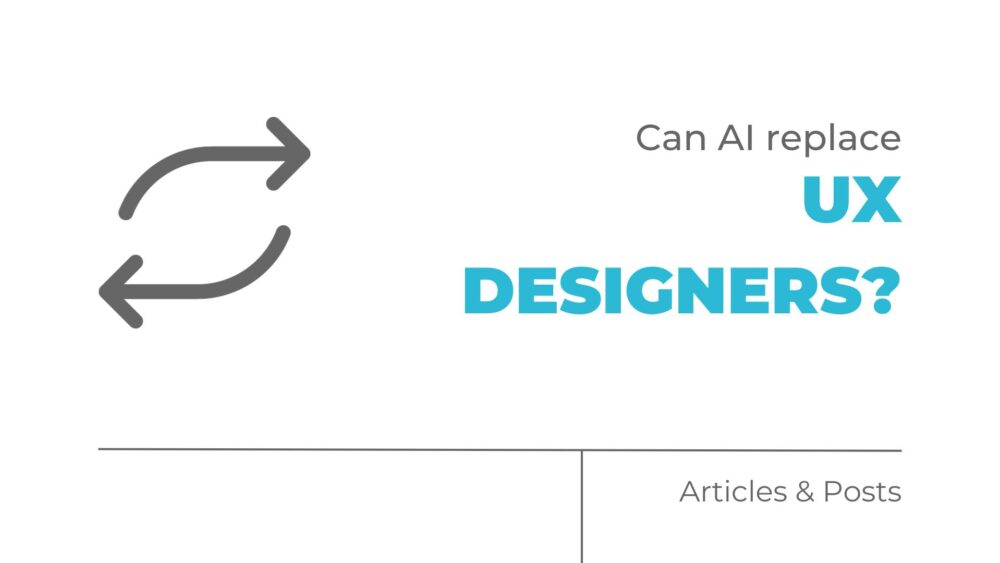With the rapid advancement of artificial intelligence (AI) technology, it’s natural to wonder how it may impact various industries.
In the realm of graphic design, specifically user experience (UX) design, the question arises: Can AI replace UX designers?
This concern stems from the growing use of AI in automating tasks and streamlining processes.
Basically, though, while AI will take over some actions, AI cannot replace the role of the UX designer in creatively connecting to people and their thoughts and emotions.
A person is a person. AI is AI.
That said, let’s explore what the future holds for UX designers in the age of AI.
Will AI Affect UX Designers?
Yes, it certainly will.
It already has.
The role of UX designers revolves around creating intuitive and engaging digital experiences for users.
AI-driven tools can assist UX designers by automating repetitive tasks such as generating layout suggestions or analyzing user data.
These tools can save time and enhance efficiency, allowing designers to focus on more strategic and creative aspects of their work.
Can AI Be Used for UX Design?
There is no doubt that AI holds immense potential in enhancing the abilities of UX designers.
AI algorithms can analyze vast amounts of user data, enabling designers to gain valuable insights into user behavior and preferences.
By leveraging this data, designers can create personalized experiences that cater to individual user needs.
Additionally, AI-powered design tools can help streamline the design process.
For instance, AI algorithms can generate design variations based on predefined parameters, allowing designers to explore different possibilities quickly.
These tools can also assist in automating repetitive design tasks, freeing up designers to focus on more critical aspects of their work.
Is UX Design AI-Proof?
Basically yes.
While AI can assist and enhance the work of UX designers, it is unlikely to render them obsolete.
The human aspect of UX design, such as empathy, intuition, and creativity, cannot be replicated by AI systems alone.
Designers bring a unique set of skills and insights to the table, allowing them to understand complex human emotions and motivations.
A computer cannot do that.
Moreover, UX design is not solely about creating visually appealing interfaces.
It encompasses understanding user needs, designing for accessibility and inclusivity, and solving complex problems.
These aspects require critical thinking, collaboration, and a deep understanding of human psychology – areas where human designers excel.
Therefore, while AI-driven tools can certainly assist with the process, but UX design is ultimately a human endeavor.
Will AI Replace Graphic Designers?
No, AI will not replace graphic designers, UX designers, or motion graphics designers.
While AI can automate certain design tasks, the creative and strategic thinking that graphic designers bring to the table cannot be replicated by AI alone.
Graphic designers possess a keen eye for aesthetics, storytelling, and brand identity, which are essential for creating memorable and impactful visual experiences.
Rather than replacing graphic designers, AI can serve as a powerful tool for enhancing their creativity and efficiency.
Will UX Design Be Automated?
No, UX design will not be automated.
It’s not possible. Here’s why:
UX design is a creative process that requires human intuition and understanding of complex user needs and motivations.
It involves understanding the psychology behind how people interact with technology and crafting experiences to meet their needs and enhance their satisfaction.
AI can aid in automation tasks such as data analysis or generating layout suggestions, but when it comes to crafting meaningful experiences, human designers are still the only option.
AI tools can never replace the unique set of skills and insights that UX designers bring to the table.
In Graphic Design, What Jobs Will AI Replace?
While AI may automate certain repetitive tasks in graphic design, it is unlikely to replace human designers entirely.
Jobs that involve highly creative and strategic thinking, such as art direction, brand strategy, and conceptualization, are less susceptible to automation.
These roles require human intuition, emotional intelligence, and the ability to think critically – qualities that make designers indispensable in the creative process.
On the other hand, AI may impact jobs that involve more routine and repetitive tasks, like image editing or template design.
At the End of the Day
Human designers will still play a vital role in overseeing and guiding the creative process, even with AI.
It will remain up to use to ensure that the final output aligns with the brand’s vision and resonates with the target audience.
Therefore, it is essential for us as designers to adapt and change, and learn the new technology and its uses as it is made available to us.
At the end of the day, though, UX design is an inherently human endeavor – one that no machine can replace.
So, rest assured, the role of UX designers is here to stay, continuing to shape the digital landscape for years to come.


Comments are closed.